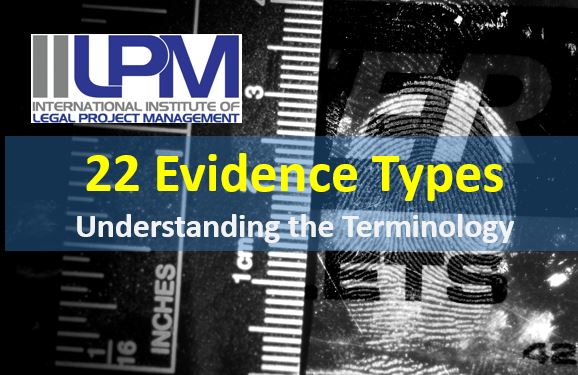In an investigation, the aim is to collect enough evidence to substantiate the allegations. This is subject to the quality of the evidence and what level of probability it offers that generally aligns to one of the following three most recognised standards of burden of proof include:
- The preponderance of the evidence – this is the lowest burden of proof that suggests the allegations are more probable than not;
- Clear and convincing – where the allegations are highly probable; and
- Beyond a reasonable doubt – which is the highest proof level where there is no logical conclusion other than the allegations.
The challenge in learning about evidence is the many categorising terms they use for it, some of which are inadmissible in a court of law, although they may help in providing an important piece of the puzzle for generally understanding how and why the alleged event occurred. Some of these terms can be applied to explaining the same evidence.
This article aims to explain all terms used relating to evidence categorisation:
- Anecdotal evidence – where you seek anecdotes that support a particular conclusion. It is not used in court, but can help in testing for scenarios;
- Hearsay Evidence – these are third party statements of people not directly involved and is not admissible in the court of law;
- Testimonial Evidence – this represents an eyewitness account as a spoken or written statement that is generally provided under oath;
- Direct evidence – that is evidence that ties the suspect to the alleged event or site without the need for inference;
- Circumstantial evidence – this is indirect evidence that aims to make an inference based on other separate evidence that effectively is a deductive technique;
- Character evidence – this is generally a testimony, reference or document that sets out to ascertain the character, credentials or state of mind of a person. Sometimes this is used to prove intent, motive or opportunity;
- Habit evidence – often referred to as ‘propensity’ evidence is linking a behaviour to previous consistent and repetitious behaviour. It aims to suggest behaviour based on previous habitual experiences.
- Expert Witness evidence – where a person who is a knowledge specialist or has a specialist skill that present their opinion about the facts or other evidence presented;
- Forensic evidence – this is scientific based evidence that uses some form of biometric that represents some human characteristics, like DNA, fingerprints, facial features, and retina scans;
- Trace evidence – this is evidence created when two objects make contact with one another;
- Physical or Real evidence – this is evidence in a tangible form that is often referred to as ‘material’ evidence and may be called an ‘exhibit” in the court and may be documents, audio visual recordings or photography or video images. This can be further broken down to: individual physical evidence that represents personal biometrics, such as validating their white blood cell DNA; and class physical evidence that represents a particular group of people (such as a blood group).
- Digital evidence – this is evidence in electronic format collected from computers, photocopiers, cameras, recorders, watches, GPS, gaming consoles, automation systems, controllers, or other electronic devices. Beyond data, it can include capturing dates and times, it generally is in the form of a document, email, video or audio recording;
- Documentary evidence – which is simply referring to written or electronic documents;
- Statistical evidence – is when numbers and statistics are used as proof. This can include measurements and calculations;
- Analogical evidence – this is a comparative technique where credibility is increased by drawing parallels to other similar events;
- Demonstrative evidence – this is when an object or document is used to directly demonstrate a fact;
- Prima Facie evidence – this is evidence based on a first impression or appearance that is accepted as correct until proved otherwise;
- Exculpatory evidence – this represents evidence that effectively clears the suspect from guilt or blame;
- Corroborating evidence – represents evidence that is supporting, authenticating or confirming existing evidence to strength the case;
- Admissible evidence – this simply means evidence that can be used by a court of law;
- Inadmissible evidence – this is evidence that cannot be used by a court of law;
- Insufficient evidence – this is evidence that fails to meet the burden of proof.
I hope these 22 terms help you better understand evidence and its different categorisations.
Remember, all evidence can provide vital clues and may be used to point toward new areas of enquiry or additional scenario analysis.
WATCH ON VIDEO
Prefer watching a video? Click https://youtu.be/vTDXkga9JTY to view the video.
ABOUT THE AUTHOR
Todd Hutchison is an international bestselling business author, a Nationally-accredited trainer, certified speaking professional (CSP), and a global legal project management and behavioural specialist. He is a part of the Executive Team of law firm Balfour Meagher and resides as the Global Chairman of the International Institute of Legal Project Management. Todd is involved in training of police, military, corrective services, lawyers, auditors and investigators.

